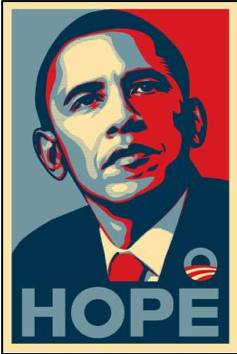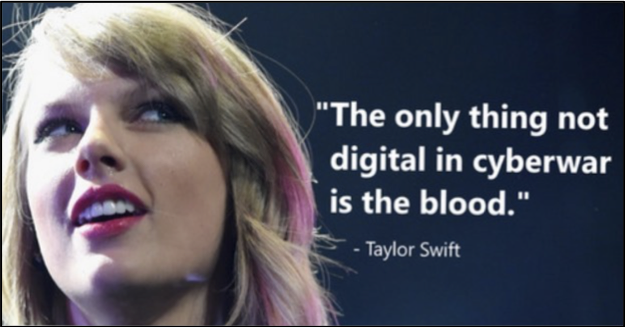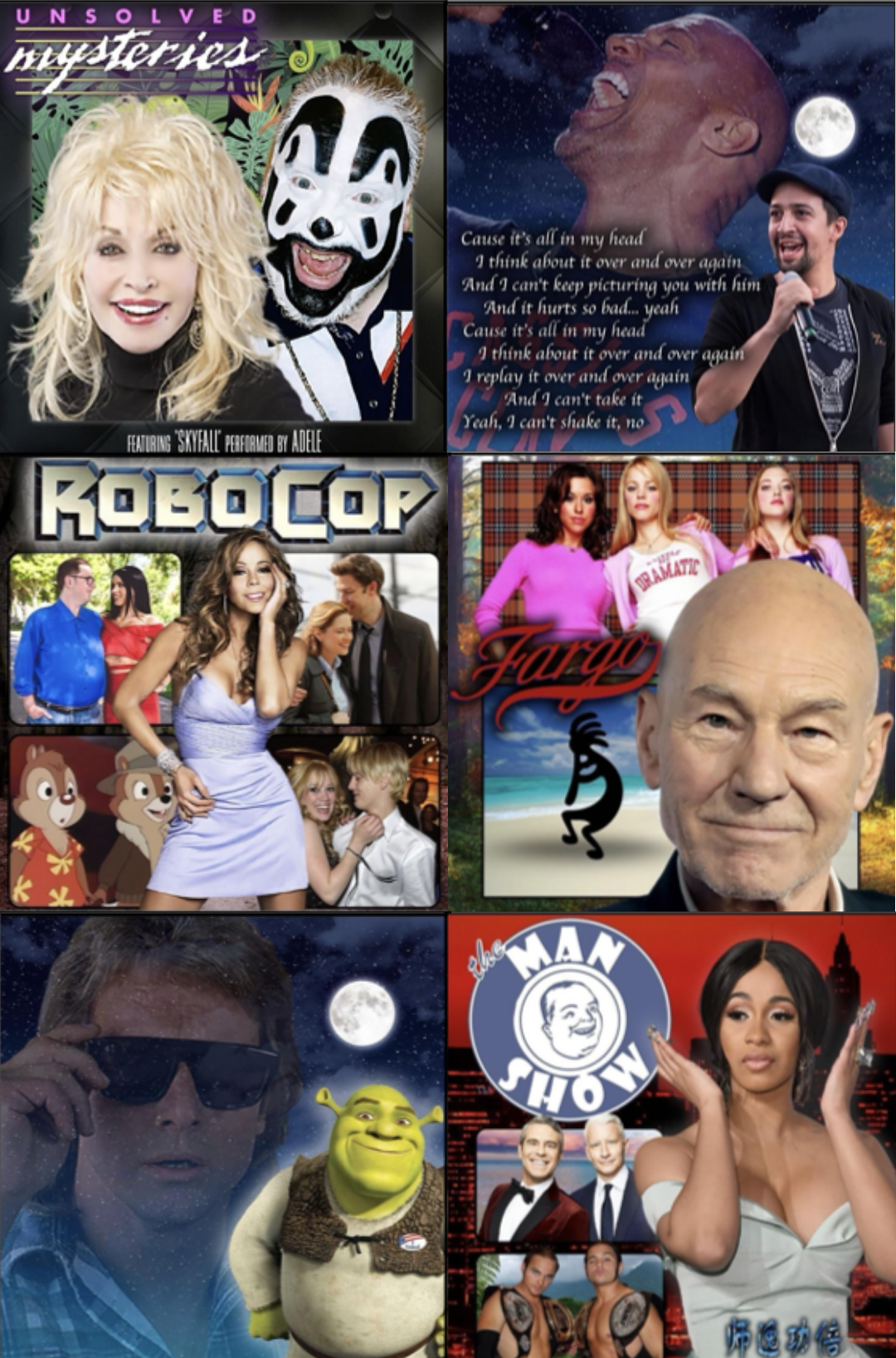Appropriating Celebrity: The Efficiency of Digital Detournement
Posted by <Dale Eisinger> on 2022-02-15
bIn late 2011, Dr. Robert Finkelstein, the president of a robotics technology company, gave a presentation to the Social Media for Defense Summit, in Alexandria Virginia. Finkelstein titled the presentation, Tutorial: Military Memetic. Citing Rumsfeld, Clinton, Patraeus, and Ali Soufan (an FBI Al Qaeda interrogator) Finkelstein established that the bulk of warfare in the 21st century takes place in the field of information—that is to say, through cybernetics and the internet. His research took inspiration from projects funded by the Defense Advanced Projects Research Agency (DARPA, the government department which also developed the nascent internet) and included foundations in “Epidemiology of Ideas” and “Social Networks in Strategic Communications.” The researchers sought ultimately to predict the changes in rapid information networks, by utilizing what Richard Dawkins called the meme. Memes, says Finkelstein and Dawkins, self-propagate in active contagion, influence behavior, and persist, electronically through imagery, short text, and easily accessible graphic interfaces. Though Finkelstein and the state-funded DARPA researchers appeared to be perniciously ahead of the curve, nine years later, memes are commonplace in the daily experience of web browsing, social media feeds, and even political campaigns.

The celebrity is the spectacle personified, a semantic system of reference that embodies, for the fan and/or viewer, a host of representational information that can develop, in its strongest form, trust. In the celebrity, Debord tells us, one is free to express globally a social experience that implies liberation, that leads logically to the reliability of endorsement simply through existence. We do not experience life outside the image, as the image is the logic of commodity choice; we make consumer choices based on simulacra, so the mere image existence of celebrity creates endorsement. The worship of celebrity becomes but one aspect of this myopia of spectacle experience by reducing uncertainty in exploiting the credibility of the celebrity (who is the opponent of the individual, says Debord). In the digital media literacy of the public, years behind military development, under cybernetic conditions of the algorithmically targeted meme, the spectacle of celebrity converges a total reduction of uncertainty in the meme. That repetitive
sameness, that non-ending of history to the comfort of neurosis, the implacability of the schizophrenic within the sterile and same of all social space—the algorithm affirms identity through meme in this way. By being an individual known for being known, as Boorstin dubs the celebrity, an affirmation produces out of mere representation, while perhaps detached from the concept arising from the meme. Here we can examine perhaps the first meme of the modern political era: the
image of Barack Obama with the word “hope” underneath, created by
Shepard Fairey, propagating both digitally and in analog through 2008
and to this day. The representation of Obama in celebrity—as the relief of racial hierarchy from structural US society—his charm and eloquence, helped obscure the concept of his presidency: a lifelong political player whose first major act in office was to bail out Wall Street, while ruthlessly pursuing Snowden, Manning, Assange, and their ilk. Here we understand the political pamphlet or poster as the ur-meme, that within what information becomes obvious: reduce the uncertainty of the vote, yet abandon hope.

While the point here rests on the obfuscation of structural outcomes, we also understand Drake’ and Higgins’s notion of the political celebrity and the celebrity politician. The authors make clear that politics and celebrity interweave now to the extent of the indistinguishable. Yet it is offensive to some to point out the fandom of politicians is as intense as that of “entertainers.” When taken in the framework of Jodi Jensen, who argues that distinguishing between fandom and afficandom is classist and elitist, we see the politics of celebrity in the light of pathological fandom. Fandom (that is to say, the sustained scrutiny and appropriation of celebrity spectacle) is a way we make sense of the world, by helping sort and categorize history and society, developing meaning out of the every day, even the everyday interaction with memes. Kloet and Van Zoonen echo this position, claiming that through fan culture, one performs difference, perhaps in the form of adopting political positions in the reduction of uncertainty of difference to be performed. So fandom is not fundamentally different from art or politics; rather, the only distinction is the nature of the textual object. Individuals accumulate cultural capital in order to produce an authentic self, through fandom as a performative act. While traditional identifying aspects, such as gender, age, ethnicity, sexuality, and class are easy to triangulate within the performative act, the political activation of the fan becomes another performative aspect of the potential of fandom to shape societies and social norms. The celebrity politician, or the political celebrity, provides endorsement by proximity. This hinges on the idea of parasocial relationships, developed by Wohl and Horton, and quoted by Keiles: “The spectacular fact about such personae is that they can claim and achieve an intimacy with what are literally crowds of strangers. This intimacy, even if it is an imitation and a shadow of what is ordinarily meant by that word, is extremely influential with, and satisfying for, the great numbers who willingly receive it and share in it.” Returning to Boorstin, the move from hero to celebrity enables the efficacy of military memetics by sheer representation in the parasocial.
As mentioned above, Debord and the Situationist International (the art movement he belonged to) began formulating a counterinsurgent method of image warfare, in the late ‘50s. The need for a new kind of educative propaganda arises, one that counters the totality of the image commodity, by using the image commodity itself to disrupt and short circuit the cultural logic of capitalism. They called this strategy “detournement.” Detournement is the revolutionary act that battles the atomization discussed above, by unifying discrete events of any kind (a forced dialectic), explained, notably for our purposes, in “A User’s Guide to Detournement” and “Detournement as Negation and Prelude.” The basic idea revolves around unifying the intuitively un-unifiable (that intuition arising out of the logic of capital) developing a “parodic-serious stage” that disrupts the narrative confirmation bias of the image commodity, abandoning indignation, laughter, and originality, in favor of rendering a new sublimity. To quote the “Handbook”:
Any elements, no matter where they are taken from, can be used to make new combinations. The discoveries of modern poetry regarding the analogical structure of images demonstrate that when two objects are brought together, no matter how far apart their original contexts may be, a relationship is always formed. Restricting oneself to a personal arrangement of words is mere convention. The mutual interference of two worlds of feeling, or the juxtaposition of two independent expressions, supersedes the original elements and produces a synthetic organization of greater efficacy. Anything can be used.
Though the gauche aesthetics paired with virulent political messaging of the Gravel campaign border on the detourned, they actually seek to reinforce the bias of Left-curious individuals who simply need a push to expand the Overton window. This reduces the uncertainty that “more extreme” political positions inoculate a fandom culture that renders the individual not quite so alone in the counterintuitive arising from contradictions of late capitalist narrative and adolescent experience. Further, Gravel is not a celebrity. The parasocial relationship barely exists, and the further purpose of the meme could arguably be to make Gravel into a celebrity politician, through the semiotics of youth. The Obama meme, on the other hand, employs a celebrity politician in pure representation of acceptable political aesthetic, expanding the Overton window from both sides, in obfuscating the reproduction of conditions that enable the surveillance apparatus, drone warfare, suppression of information, and other aspects of concept detached from the required affirmation bias of countervailing cultural logic. It is not detourned—it operates precisely under the terms of spectacle culture, avoiding alienation by wide margins, fully reducing the uncertainty of performative difference. Obama, as meme, is the everyman.
So what does a properly detourned meme look like? Against the logic of the military memetic, I believe the goal of detourned information inverts, to arouse uncertainty, rather than reduce it. In the battle of the ever-affirming image commodity, the certainty of reproduction must be reversed. One example could be what hackers commonly refer to as “hashtag hijacking.” In a recent instance, Alt-Right individuals began circulating a trending topic under the #ProudBoys tag. Gay men swarmed the internet to post under the hashtag, detourning the ownership of a fascist ideological space with photographs of “proud boys” kissing each other. While this example reverses the political oppression intended of the original instigators into the irrefutable act of love, it can only be defined as memetic in the broadest sense. More effective in the digital detournement are single-pane image monads similar to the two examined above. And, in the strongest form of detournement, the appropriation of celebrity to the form, by exploitation of the spectacular, arouses the most uncertainty through the efficiency of the counterintuitive.

In detournement, the more separated the original elements are, the more effective. In the case of the above image, sourced from the Twitter account @SwiftOnSecurity, the musician Taylor Swift (a “deceptive” detournement, in that celebrity is a strong representation) is paired with a fallacious quote (a “minor” detournement, an origin of indifference). The meme succeeds for several reasons. First, it disrupts the algorithm by infiltration similar to hashtag hijacking, providing a counternarrative within the machinery of affirmation bias (the Twitter algorithm, for example, notoriously upgrades pictures of white women). Second, it appropriates celebrity to the order of fandom, calling into question the reality of Swift’s engagement (until very recently, Left-leaning music press lambasted her for being reliably apolitical, citing her “country” roots and its mainstream affiliation with fascist tendency). The appropriation of celebrity in the space of detournement arouses uncertainty to a great extent, exploiting the fundamentals of fandom to force a new meaning of the world, by attributing a nonexistent cause célèbre to the spectacular parasocial relationship. In the least, the idea of “cyberwar” sublimates to the momentary confusion of the fan, in the evaluation of the forgery. In the best case, the fan interrogates the ideas offered on the liminal stage; if unfamiliar with “cyberwar,” say, an activation occurs from the detournement of exploration.
However, the subtle absurdity of this meme does not come close to the full potential of celebrity appropriation in the detourned counterinsurgent memetic. The fact it is so easily explainable makes it a relatively weak form of the counterinsurgent. The fully detourned operates on the sublimity of the inexplicable.

The six images above, sourced from the Instagram account @selfies_food_and_pets, demonstrate the strong form of memetic detournement, appropriating celebrity to the subliminal and inexplicable. The necessity to understand, the efficacy of the affirmation bias of the algorithm, ruptures under the fully deceptive detournement at work. These six images represent thousands of similarly inexplicable memes by the author, that, examined as a body of work, purposefully elide concept in favor of the full power of spectacular representation. Fandom, celebrity, counternarrative, and the absurd reveal the irrational cultural logic of late capitalism by never providing resolution, revealing the unending, endless present of spectacle culture. By employing detournement (either consciously or not) the author deconstructs the unity of image as the final form of commodity, revealing the pathology of fandom as arbitrary, socially constructed, and rife with political bias. The basis of celebrity affirms this, exploiting parasocial relationships to disrupt the easy categorization of the world, which fandom generally serves. It would be somewhat futile to attempt an attribution of meaning, here. And yet, a sense of purpose imbues these works. In the convergence of the atomized and appropriated celebrity, the viewer sublimates critical ideas, the forced dialectic of the unconscious: populism, police brutality, the male gaze, commodity fetishism, the spectacular Other, revisionist history, the masculine/feminine divide, and the hegemony of leisure, all at a glance—and unified in detournement.
The final analysis reveals the purpose of the image commodity: to continue atomization of the mass, to arbitrate discretion, to negate the communal experience, and to reduce uncertainty. The image commodity, even in the weak form, is simply a meme. The celebrity, as the representation of liberation, is the strongest form of meme. We then see detournement as the strategy of negating that negation, of obviating the psychic divides of spectacle culture. One might comment on the absurdity of the enterprise. I submit degrees of skill and knowledge are required to unify the counterintuitive into the revelatory, using discretion to unmask the systematic reproduction of the image commodity—ultimately showing the absurdity of that enterprise. To know the national security state operates on memetic lines of thinking, as discussed in the opening of this paper, requires any individual who values real social advancement to consider the power of digital detournement, in the most efficient form, to combat the hegemony of the affirmation bias. The most spectacular form of the image commodity, in the celebrity politician and the political celebrity, arises by fiat, when appropriated in the detourned meme. The disruption of normative, performed difference, in the appropriation of celebrity, by forcing discretion into the counterintuitive, forms a basis and example of digital detournement, as an efficient counterinsurgent strategy of the everyday.